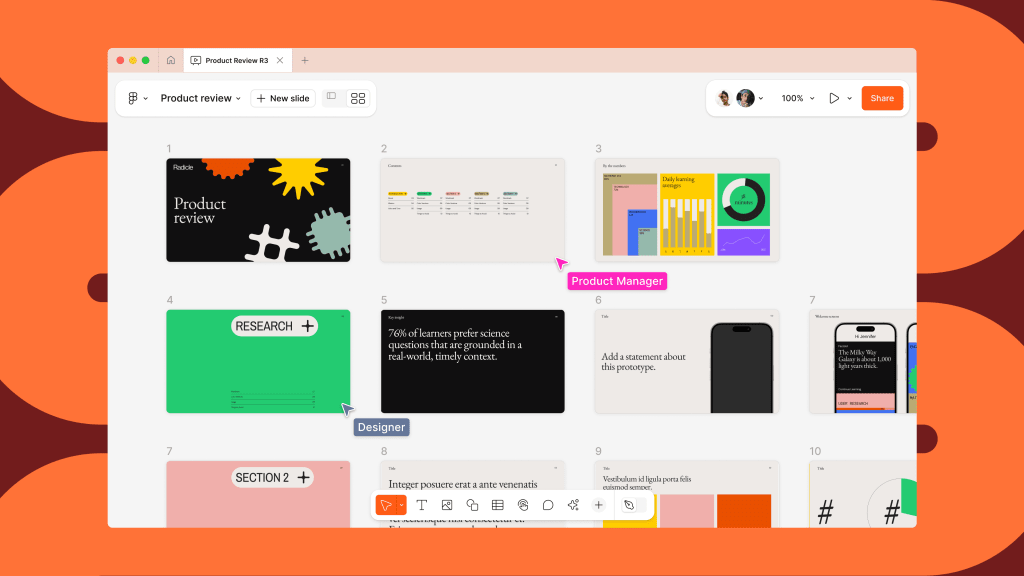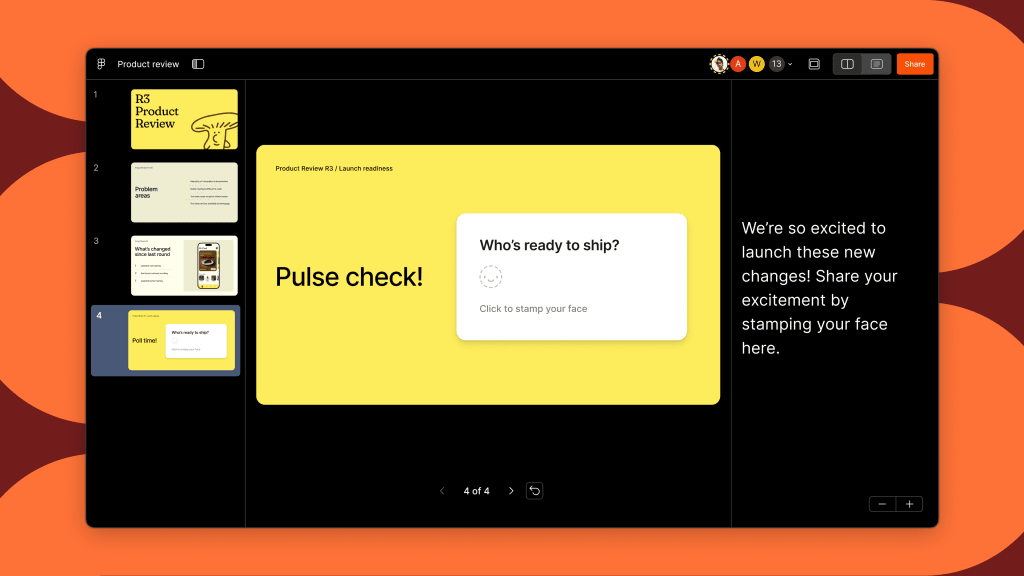In a sense, Figma has been in the presentation software business for years—just not on purpose.
The company’s namesake product is a web-based design platform optimized for prototyping user interfaces, not assembling and conducting slideshows. Nonetheless, plenty of users commandeered it for that purpose. In just the past 12 months, users have created 3.5 million slide files, the company says.
Today, at its Config conference in San Francisco, Figma is unveiling a real presentation product. Logically named Figma Slides, it joins the company’s design tool and FigJam whiteboard to form a visual communications suite of sorts. Launching as a free beta available to anyone who’d like to try it, Slides will become a paid feature once it officially ships.
Dylan Field, Figma’s cofounder and CEO, is one of those folks who was already using the platform as an ad hoc presentation package. But he doesn’t take credit for seizing the opportunity to formalize that function with Figma Slides. Instead, he says he gave in to a groundswell of internal support. “Folks who were already inside the company [said] ‘Hey, we need a product,’” he told me earlier this week. “It was never a top-down directive. Honestly, it just emerged.”
By extending Figma’s reach into a mainstay of business software such as presentations, Figma Slides does reflect one of Field’s own mantras about the future of his company and work in general: that creativity is the new productivity. The app also helps build out what Figma looks like as an independent business after the collapse of Adobe’s $20 billion acquisition bid, which was bedeviled by antitrust concerns and ended last December. So does the other news it’s announcing at Config, including a redesign of the design tool, more pervasive use of AI across the platform, and revisions to “Dev Mode,” which facilitates the process of turning prototypes into working products.

Still, for all the arguments in favor of Figma embracing presentations, it’s not like it’s entering an emerging market without deeply entrenched competition. Few software products are as synonymous with their category as Microsoft’s 37-year-old PowerPoint. Organizations that aren’t paying for it as part of Microsoft 365 (née Microsoft Office) probably have access to Google Slides, a component of Google Workspace. Field acknowledges that “a graveyard” of other alternatives have come and gone over the years.
But he stresses that the current field has room for multiple players: “Canva Presentations might be one of the biggest ones out there, and Tome is growing fast. There are so many slide products.” Perhaps more important, Figma isn’t rash enough to think it can kill PowerPoint. The idea, Field says, is to offer a great presentation option for Figma’s core constituency: “people who are building products.”
That’s a sizable audience in itself. Though Figma doesn’t disclose how many users it has, one 2023 survey said that 70% of design professionals cited it as their primary tool. Once designers within an organization embrace the platform, it tends to spread: All told, usage is evenly split among designers, developers, and other folks who participate in product development, the company says. Field predicts that students—who can get the whole Figma platform free—will also like Figma Slides.
At last: presenter notes
Based on the demo Field gave me over Zoom, Figma Slides certainly looks like a Figma product. It’s a polished, wholly browser-based experience with built-in real-time collaboration features akin to those in the company’s design tool and FigJam. But feeling Figma-esque wasn’t enough. For example, a presenter notes feature was mandatory: “It’s a very simple thing, but it’s probably one of our most-requested features for Figma,” Field says. The company also created a grid view optimized for viewing an entire show in thumbnail form and shuffling slides around.
Presentation templates were another necessity, and given Figma’s design orientation, the quality bar was high. “We have all sorts of templates we’re shipping with, and those templates give you a ton of control,” Field says. The app does a fair amount to ensure visually pleasing results on its own, such as intelligently adjusting text color to ensure legibility when you change the background. But users who want absolute freedom to specify typography, shapes, and other elements can turn on Design Mode, which provides access to a wealth of existing features. They can also drag design prototypes created in Figma right onto slides, where they continue to function—a killer feature that PowerPoint and Google Slides can’t replicate.
Along with everything Figma Slides does to let users handcraft exactly the presentation they envision, it also packs some generative AI. (Hey, this is 2024—of course it does!) For example, a Tone feature lets you use AI to auto-rewrite slide text on two axes: “Concise” to “Expanded” and “Casual” to “Professional.” You can also just tell the app to reword your phrasing in a style such as “Executive,” “Technical,” or “Educational.”

Oddly enough, Field didn’t mention the AI features Figma Slides has until I asked about them—a striking departure in an era when many tech executives won’t shut up about the technology. He’s hardly an algorithmic Luddite: For example, he says that one of Figma’s priorities is to help neophytes get going on its platform. AI can help by generating images, text, and entire designs, ensuring that they aren’t scared away by a blank canvas.
But rather than talking up automation for its own sake, Field, who told me in 2021 that the company wanted to make sure its FigJam whiteboard let “the humanity [shine] through,” emphasized similar goals when I spoke to him about Figma Slides. The app lets people viewing a slideshow participate with features such as stamps and polls—a dollop of interactivity far afield from business presentations in their stereotypical, largely one-way form.
“What’s been wild with FigJam is that our differentiator is fun,” Field says. “And the more fun you can make a meeting, the more that you can get people to express [themselves], to bring their ideas to the board, to participate. I think people are going to see the same thing in Slides.”
With AI’s tendency to mechanize aspects of work that were once the province of the human mind, concepts like fun, self-expression, and participation can feel endangered. Field, however, argues that they’re only becoming more crucial. “We’re in a world where AI is just going to make everybody more productive,” he says. “And my view is that creativity is going to be how you stand out. Actual unique thinking—going down divergent paths, working past clichés.”
Historically, presentation software’s reputation for inducing tedium has been so pervasive that even Microsoft has acknowledged the phenomenon of “death by PowerPoint.” It would be pretty cool if a product such as Figma Slides not only overcame that regrettable legacy but sparked the kind of fresh thinking Field is talking about.
You’ve been reading Plugged In, Fast Company’s weekly tech newsletter from me, global technology editor Harry McCracken. If a friend or colleague forwarded this edition to you—or if you’re reading it on FastCompany.com—you can check out previous issues and sign up to get it yourself every Wednesday morning. I love hearing from you: Ping me at hmccracken@fastcompany.com with your feedback and ideas for future newsletters.
<hr class=“wp-block-separator is-style-wide”/> https://www.fastcompany.com/91145153/figma-slides-presentations-config-2024?partner=rss&utm_source=rss&utm_medium=feed&utm_campaign=rss+fastcompany&utm_content=rss
Autentifică-te pentru a adăuga comentarii
Alte posturi din acest grup

Amazon plans to invest $10 billion toward building a campus in North Carolina to expand its cloud

Rather than sitting at home and watching your favorite influencers unbox gifts from their all-expenses-paid brand trip, now the rest of us have a chance to feel like an influencer for a day.

When Spencer Rascoff took over as CEO at the struggling dating app giant Match Group in February, one of his first orders of business was to acquaint himself with all the services under his purvie

Artificial intelligence began

Earlier this year, a robot completed a half-marathon in Beijing in just under 2 hours and 40 minutes. That’s slower than the human winner, who clocked in at just over an hour—but it’s still a rema


Everyone’s always talking about new tools, but some of the best tools are the classic ones—incredibly useful things that have been around for ages. These are the tools that have stood the test of
